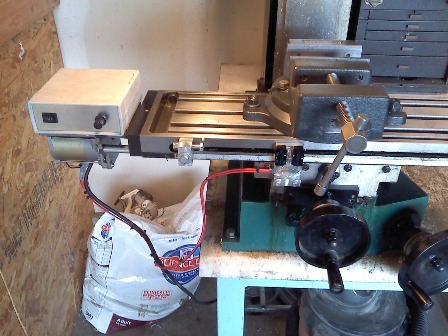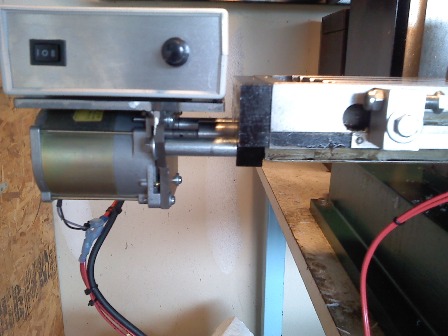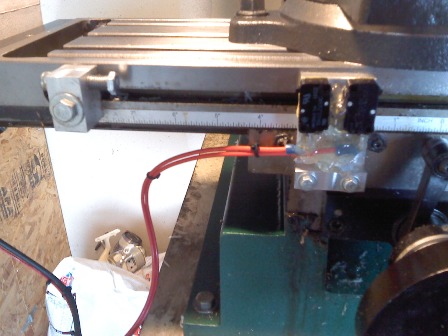

24 VDC Gear Head Motor
I went down to the ol' base-o-ment and pulled out a drive motor from snowbot. I got these motors on ebay a couple years back for about $10 each, it was a good deal. They run on 24 VDC, draw about 2 amps
under load and rotate at 180 RPM. The only bad thing about them is the face mounting threads are metric, but I was able to find some outrageously priced metric screws at my local chinese junk dealer, ACE hardware.
The output shaft on the motor is metric Iím sure, but it's about 5/16" diameter so let's just call it 5/16". 50 Watts is half the rated power of the Grizzly table feed, but since the motor was at 'no cost' I figured I'd give it a try and if it didn't work, I just put a bigger motor on there.
24 VDC Power Supply
For some reason I don't seem to have any good 24 VDC power supplies. I have a lot of those wall transformer guys but most are limited to about 1 amp. Because this thing was going to pushing my mill table
and machine parts, I didn't want to risk underpowering an already possibly under capacity motor. So I found a deal at all-electronics, a favorite surplus electronics dealer of mine for a totally enclosed, fan-cooled, 24 VDC power
supply with standard AC cord input, local power switch and a 4 amp capacity for only $25. What a deal, I bought it. This power supply is good for up to 100W, so again if the motor is too small I can easily upgrade
and use the same power supply. The power supply is mounted to the bottom side of my work bench table-top. It's out of the way and I can easily switch it ON when I need it.
24 VDC Motor Speed Controller
Ok, here's where things got interesting. I needed a 24 VDC motor speed controller rated for at least 100 W (in case of upgrade) that was reversible and cheap. Well I found a bunch of similar ones with
H bridges but I thought I wanted one with a real reverse/forward switch instead of just a single pot. It took me a while but I ended up on ebay of all places. I bought a 200W unit with reverse polarity
relays, switch and potentiometer shipped directly from china for about $30. You just never know what you get until it shows up, but in this case I was impressed. The soldering joints looked good and
it didn't stink too badly. The only sketchy thing was the IC's had all their markings sanded off. So either they wanted nobody to copy the IC chips (making replacing them difficult) or they used a batch
of stolen, defective or otherwise non-ligite IC's to save a dime. But when I tried it out, heck it worked just fine! I mounted the speed controller in a project box I had previously purchased for a 'bat-detector',
which, never worked anyways.
Mounting Hardware
Well I got all my junk together and made a design in ACAD for the whole thing. So really all
I needed to do was mount a motor bracket to the milling machine with enough space between the two to accommodate the 'slide collar' that allows disengagement of the feed without removing the entire assembly.
The slide collar slides up and down the motor shaft and a cross-shaft in the motor shaft transmits the rotation motion from the motor to the slide collar. The slide collar is then tabbed to fit into the milling
table screw slot. It was tough getting the dimensions of the bolt patterns from the milling machine. I'm not too good at measurements. The motor bracket was made from 1/4" steel plate and welded together. I got this plate from the local steel supplier, Fausers.
Limit Switches
Well going through all the trouble of making limit switches sure is a lot of work. But since I was waiting for the boat from china that was carrying my motor speed controller I had nothing better to do.
So I looked in the basement again and pulled out two identical limit switches, likely from microwave ovens plucked out of a dumpster somewhere. I made up a mounting bracket to place the limit switches
in the same spot the grizzly system uses (thanks griz!). These switches are wired in series with the motor power so if they trip, all power to the motor is lost. Also from the griz system are two positionable spring
loaded limit switch smackers. They're spring loaded so that when the limit switch gets hit at mach speed, there is some room for the table to keep moving before it rips the mounting bolts out of the limit
switches. What a good idea, i thought so.
Power Mowing
I tried out the motor feed control with a fly cutter on some aluminum plate and the results were excellent. The speed range was certainly not too fast with good slow speed range control. I don't think faster
would save me much, at least with this little milling machine. I also plowed through some plastic parts at full speed and that little gear head motor had no issue at all. I haven't used it much on steel parts
but for aluminum and plastics it has worked well. I do wish I had mounted the motor control box on the bottom side of the motor so everything would be flush with the milling table instead of sticking
above it.
Link to the initial design of the motorization.



Design01
Design02
Design03
Design04
Design05
Design06
Copyright 2010, Greg Miller
https://www.angelfire.com/80s/sixmhz/tablefeed.html